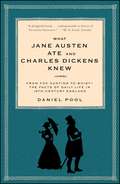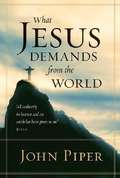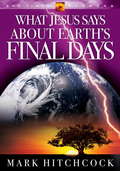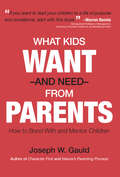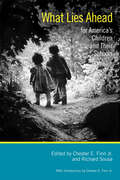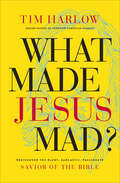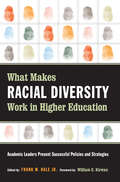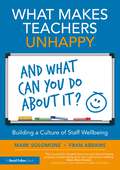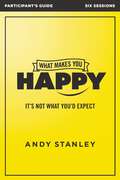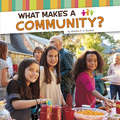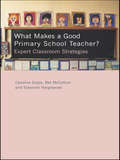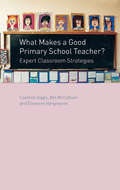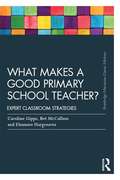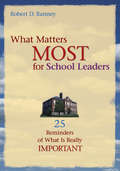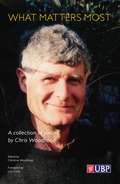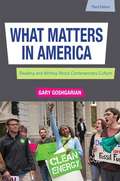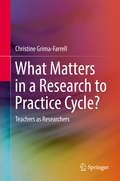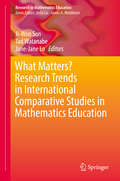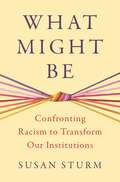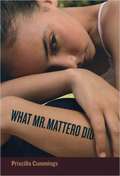- Table View
- List View
What Jane Austen Ate and Charles Dickens Knew: From Fox Hunting to Whist-the Facts of Daily Life in Nineteenth-Century England
by Daniel PoolA "delightful reader's companion" (The New York Times) to the great nineteenth-century British novels of Austen, Dickens, Trollope, the Brontës, and more, this lively guide clarifies the sometimes bizarre maze of rules and customs that governed life in Victorian England.For anyone who has ever wondered whether a duke outranked an earl, when to yell "Tally Ho!" at a fox hunt, or how one landed in "debtor's prison," this book serves as an indispensable historical and literary resource. Author Daniel Pool provides countless intriguing details (did you know that the "plums" in Christmas plum pudding were actually raisins?) on the Church of England, sex, Parliament, dinner parties, country house visiting, and a host of other aspects of nineteenth-century English life--both "upstairs" and "downstairs. An illuminating glossary gives at a glance the meaning and significance of terms ranging from "ague" to "wainscoting," the specifics of the currency system, and a lively host of other details and curiosities of the day.
What Jesus Demands from the World
by John PiperThe four Gospels are filled with demands straight from the mouth of Jesus Christ. These demands are Jesus' way of showing us who he is and what he expects of us. They are not the harsh demands of a taskmaster. For example, the demand that we come to Jesus is like the demand of a father to his child in a burning window, Jump to me! Or like the demand of a rich, strong, tender, handsome husband to an unfaithful wife, Come home! What Jesus demands from the world can be summed up as: Trust and treasure me above all. This is good news! In What Jesus Demands from the World, John Piper has gathered many of Jesus' demands from the four Gospels. He begins with an introduction that puts the demands in a redemptive-historical context, then concisely examines each demand. The result is an accessible introduction for thoughtful inquirers and new believers, as well as meditative meat for veteran believers who want to know Jesus better. The Christian gospel is more than just a wonderful offer of saving grace; it is a demand for supreme loyalty, for surrender to the lordship of Jesus. We forget this too easily in our contemporary church, besieged as we are by a philosophy of pluralism that rejects ultimate authority and a culture of rights that scorns submissiveness. But John Piper reminds us of the real truth: obedience to Christ's commands is our absolute duty; yet, paradoxically, in his service is perfect freedom and joy! William J. U. Philip, Minister, St George's-Tron Church, Glasgow, Scotland, UK.
What Jesus Says about Earth's Final Days
by Mark HitchcockTwo days before He died, Jesus gave His closest followers a sweeping panorama of earth's final days. Responding to questions about the end times, Jesus' great speech on the Mount of Olives described the tribulation and His second coming - and offered several famous parables of practical application for the disciples. In a powerful indication of His priorities, Jesus devoted twice as much time to telling His followers how to live in light of His return as he did to describing the actual event. Readers will be inspired and equipped to live faithfully in expectation of Christ's coming.
What Jesus Taught About Manifesting Abundance
by John AvanziniYou will find that one uninterrupted revelation threads its way through the entire chapter. It reveals the method for manifesting abundance in your life, and it lies within the simple truth of sowing and reaping.
What Katy Did At School (Katy #2)
by Susan CoolidgeKaty's aunt believes she and her younger sister, Clover, should go to boarding school to learn the social graces. Their father is skeptical, but agrees to send them for a year. This book tells the story of their adventures, and what Katy did at school.
What Kids Want and Need From Parents
by Joseph Warren GauldWhat Kids Want-And Need-From Parents is truly a seminal book in parenting.It begins with one man's 50-year journey to discover a better way to prepare American kids for life and culminates with the amazing discovery: the biggest factor in children's success in life turns out to be dependent on how their parents deal with their own childhood!Teacher Joe Gauld sets out to change American education in the 60s, founding the Hyde School in Bath, Maine, committed to the idea every student is gifted with a unique potential. But by tracking Hyde graduates in life, he finds parenting a much larger influence on their later lives than schooling. So in 1974, he begins a program to regularly address parental growth and family issues.Hyde's extraordinary ability to bond family and school receives national media attention, and Hyde grows into a network of seven private and public schools, plus a national Hyde Biggest Job® parent program.Joe increasingly centers his work on families, finding parenting heavily influenced by how parents were raised. So parents' learning how to effectively deal with both the negative as well as the positive aspects of their upbringing becomes critical to effective parenting. Joe carefully leads the reader through this dynamic and ground-breaking parenting process.
What Lies Ahead for America's Children and Their Schools
by Chester E. Finn Jr. Richard SousaThe coming decade holds immense potential for dramatic improvement in U.S. education and in the achievement of American children and in this volume, members of the Hoover Institution's Koret Task Force on K–12 Education examine both the potential gains and the pitfalls that lie ahead, informed by where U.S. education has been, what changes have been made in recent years, and what's still required for the comprehensive overhaul that this vital enterprise so urgently needs. Looking backward is infinitely easier than predicting the future, but planning for the future is necessary if anything is to change and by analyzing the recent past and present condition of American primary and secondary school education across a host of key topics, task force members in this volume chart a bold course for the years ahead. Optimistic about the opportunities at hand, they identify essential—and feasible—reforms as well as the barriers that must be overcome if those changes are to occur. They offer high-quality scholarship and thoughtful prescriptions for productive policy alternatives.
What Made Jesus Mad?: Rediscover the Blunt, Sarcastic, Passionate Savior of the Bible
by Tim HarlowWhile Christians love to focus on a gentle, tender Jesus, Harlow offers an unforgettable reintroduction to the true character of Jesus and invites us to get to know the savior who was gracious but also blunt, sometimes sarcastic, and wildly passionate about bringing people to the heart of God. We often don&’t know what to do with the Bible&’s stories of Jesus' righteous rage. Yet the truth is, while the Son of God was loving and tender, his words could be equally sharp and biting. The same man who said, &“Love your enemies&” (Matthew 5:44) also said, &“You snakes, how will you escape being condemned to hell?&” (Matthew 23:33). With compelling storytelling and enlightening examinations of Scripture, Tim Harlow journeys through the gospels and looks at what, and who, ignited Jesus&’ anger. He guides us through instances of Jesus&’ anger in response to the barriers people put up:in the temple, where money changers literally denied access to the Father, especially for the non-Jews and the poor;during his teaching, when little children were denied access;on the Sabbath, when religious leaders put rules above relationship and suffering above healing; and many more.What if, Harlow asks, by coming to understand God&’s holy anger, we come to know a savior we never knew before? How can we respond like Jesus when good intentions, prejudices and judgments, traditions and rules, and selfish and joyless people conspire to keep others from God&’s presence?
What Makes Racial Diversity Work in Higher Education: Academic Leaders Present Successful Policies and Strategies
by Frank W. Hale* A unique reference describing successful diversity initiatives in higher educationHigher education, like the nation, is facing major demographic changes. Our colleges and universities recognize they not only have to be more inclusive, but that they have to provide an environment that will effectively retain and develop the growing population of ethnically and racially diverse students. How ready are they and what should they be doing?Frank W. Hale, Jr. -- known as the "Dean of Diversity" for his pioneering efforts in establishing Ohio State as one of the institutions graduating the most Black Ph.D.s -- has gathered twenty-two leading scholars and administrators from around the country who describe the successful diversity programs they have developed.Recognizing the importance of diversity as a means of embracing the experiences, perspectives and expertise of other cultures, this book shares what has been most effective in helping institutions to create an atmosphere and a campus culture that not only admits students, faculty and staff of color but accepts and welcomes their presence and participation.This is a landmark reference for every institution concerned with inclusivity and diversity. The successes it presents offers academic leaders much they can learn from, and ideas and procedures they can adapt, as they discuss and develop their own campus policies and initiatives. Contributors:Samuel BetancesDonald BrownCarlos E. CortésMyra GordonLinda S. GreeneFrank W. Hale, Jr.Margaret N. HarriganWilliam B. HarveyFreeman A. Hrabowski, IIILee JonesWilliam “Brit” KirwanPaul KivelAntoinette MirandaJoAnn MoodyLeslie N. PollardNeil L. RudenstineWilliam E. SedlacekMac A. StewartM. Rick TurnerClarence G. WilliamsRaymond A. Winbush
What Makes Teachers Unhappy, and What Can You Do About It? Building a Culture of Staff Wellbeing
by Fran Abrams Mark SolomonsMany teachers, support staff and school leaders are tired, stressed and overstretched. And even though this frequently makes the headlines, it isn’t a new problem. In this book, Mark Solomons and Fran Abrams argue staff wellbeing should be rooted in the culture and climate of our schools. They provide a roadmap to recovery for struggling schools which should lead to improvements in staff morale, workload management and mental wellbeing. With a range of real-life examples, this book focuses on how school leaders can build workplace wellbeing in even the most challenging environments. It includes clear links to research evidence and summaries of the key steps necessary to deal with common issues such as: Identifying and mapping issues in your school Leading for wellbeing Creating and maintaining a happy workforce Developing a culture of everyday wellbeing Overseeing change. Written in an entertaining yet informative manner, this is the go-to guide for school leaders who want to support staff by building a more positive and supportive workplace.
What Makes You Happy Bible Study Participant's Guide: It's Not What You'd Expect
by Andy StanleyEverybody wants to be happy. Everybody is on a happiness quest. For many, happiness is measured in moments. Experiences. It's elusive. Unsustainable. What about you? What makes you happy? Something comes to mind for each of us.In this six-session video Bible study, pastor Andy Stanley examines the ways in which we tend to define happiness and explains how that definition influences the way we pursue it. He reveals that happiness is about who, not what, and that happy people are at peace with God, with others, and with themselves. He also shows how sin undermines peace because it separates us from God, others, and ourselves by substituting pleasure for fulfillment, things for people, images for intimacy, and self-expression for self-control.We are often tempted to believe that happiness comes from acquiring things, but happiness is actually an outcome of what we sow in our lives. We can&’t acquire, consume, or exercise our way to happiness, but we may be able to serve and volunteer our way there. In the end, we find that if we live as if it&’s all about us, we will never be happy.Sessions include:NothingPlan for ItPeace with GodHappy MoneyShoesYou&’re Not EnoughDesigned for use with the What Makes You Happy DVD (sold separately).
What Makes a Community? (Community Questions)
by Martha E. RustadDespite differences in size, location, and/or interests, all communities, from urban to rural, share certain characteristics. Through a question-answer format and easily relatable photos, young readers learn about community cooperation, responsibility, respect, and the importance of inclusion of all citizens. A simple activity tasks kids with creating their own 3-D community map.
What Makes a Good Primary School Teacher?: Expert Classroom Strategies
by Caroline Gipps Eleanore Hargreaves Bet McCallumA fascinating account of the range of teaching, assessing and feedback strategies used by individual 'expert' teachers. The book describes:*the most common lesson patterns, why and when they are used*how teaching strategies are varied according to subjects*how assessment and feedback information can encourage pupils to learn*the differences in teaching seven year olds and eleven year olds
What Makes a Good Primary School Teacher?: Expert Classroom Strategies
by Caroline Gipps Eleanore Hargreaves Bet McCallumA fascinating account of the range of teaching, assessing and feedback strategies used by individual 'expert' teachers. The book describes:*the most common lesson patterns, why and when they are used*how teaching strategies are varied according to subjects*how assessment and feedback information can encourage pupils to learn*the differences in teaching seven year olds and eleven year olds
What Makes a Good Primary School Teacher?: Expert classroom strategies
by Bet Mccallum Caroline Gipps Eleanore HargreavesWe know that successful teachers need to use a range of teaching strategies, but what are they? Bringing together fascinating, first-hand accounts of teaching, assessment and feedback strategies used by 'expert' teachers, this Routledge Classic Edition is an indispensable guide for teachers and trainee teachers looking to extend their skills and improve their practice. With a brand new foreword from Margaret Brown to contextualise the book within the field today, this accessible and concise text illustrates good teaching practice, offering a range of rich case studies and first-hand narratives. Chapters investigate a number of key areas, including the most common lesson patterns and when to use them, how teaching strategies are varied according to subject, and how assessment and feedback can encourage pupils to learn. Based on extensive fieldwork by highly respected researchers and authors, What Makes a Good Primary School Teacher? is essential reading for trainee and practising teachers, and will be particularly useful for those seeking fresh inspiration for successful approaches to assessment.
What Mathematics Can Do for You: Essays and Tips from Japanese Industry Leaders
by Toshiyuki Kobayashi Yoshikazu GigaJapan is a tiny country that occupies only 0.25% of the world's total land area. However, this small country is the world's third largest in economy: the Japanese GDP is roughly equivalent to the sum of any two major countries in Europe as of 2012. This book is a first attempt to ask leaders of top Japanese companies, such as Toyota, about their thoughts on mathematics. The topics range from mathematical problems in specific areas (e.g., exploration of natural resources, communication networks, finance) to mathematical strategy that helps a leader who has to weigh many different issues and make decisions in a timely manner, and even to mathematical literacy that ensures quality control. The reader may notice that every article reflects the authors' way of life and thinking, which can be evident in even one sentence. This book is an enlarged English edition of the Japanese book What Mathematics Can Do for You: Essays and Tips from Japanese Industry Leaders. In this edition we have invited the contributions of three mathematicians who have been working to expand and strengthen the interaction between mathematics and industry. The role of mathematics is usually invisible when it is applied effectively and smoothly in science and technology, and mathematical strategy is often hidden when it is used properly and successfully. The business leaders in successful top Japanese companies are well aware of this invisible feature of mathematics in applications aside from the intrinsic depth of mathematics. What Mathematics Can Do for You ultimately provides the reader an opportunity to notice what is hidden but key to business strategy.
What Matters Most for School Leaders: 25 Reminders of What Is Really Important
by Robert D. RamseyA primer of what is truly important for today's school leaders, this survival guide is made up of 25 fundamental insights and baseline beliefs that never change.
What Matters Most: A Collection Of Pieces
by Chris WoodheadDiscovering the passions of Chris Woodhead. Collected writings from a man who stimulated controversy and roused passions.Best known as the Chief Inspector of Schools who demanded higher standards across the board, Woodhead was admired and condemned in equal measure for his determination to confront taboos and bring them into the national education debate.His final and greatest challenge was with Motor Neurone Disease, a condition he faced with strength and empathy until his death in 2015. While his education journalism stands at the core of this book, What Matters Most explores Woodhead's lesser known passions, literature and climbing, which he writes about with the precision and clarity that became his journalistic hallmark.In the final pages of the book Woodhead shares his personal views on assisted dying, advocating for individuals to be permitted to die with dignity at a time of their choosing.What Matters Most: A Collection of Pieces is a fascinating and poignant book which tracks the life and beliefs of a truly inspirational contemporary thinker.
What Matters in America
by Gary J. GoshgarianCompact in both page count and trim size,What Matters in America's themes examine popular culture topics and provide a sufficient number of selections to make sure topics are given with adequate depth. Gary Goshgarian addresses topics of: Television Violence, Racial Profiling, Capital Punishment and Gay Marriage.
What Matters in a Research to Practice Cycle?
by Christine Grima-FarrellThis book introduces a comprehensive RTP Model that reframes research to practice knowledge and inclusive education philosophy to promote the sustained use of research to promote and enhance meaningful education for all students.
What Matters? Research Trends in International Comparative Studies in Mathematics Education
by Jane-Jane Lo Ji-Won Son Tad WatanabeThis book provides a unique international comparative perspective on diverse issues and practices in mathematics education between and among the US and five high-performing TIMSS education systems, Japan, China, Singapore, South Korea, and Taiwan. The book offers multiple perspectives on the important factors that contribute to mathematics teaching and learning in different educational systems and cultural contexts. Using large scale data generated by numerous international comparative studies, the book analyzes and provides context for various methodological perspectives. The book raises compelling questions and issues for mathematics education researchers, leading to a critical examination of what can be learned from other education systems. Authors address four major research perspectives by critically examining cross-national similarities and differences, such as research on the influence of curriculum on student learning; research on institutional systems of mathematics teacher education; research on improving teacher knowledge and pedagogical approaches; and research using large-scale data. This collection of perspectives serves as a foundation for reviewing and analyzing the international comparative studies introduced in the book.
What Might Be: Confronting Racism to Transform Our Institutions (Our Compelling Interests)
by Susan SturmHow to turn the paradoxes built into anti-racism work into drivers of learning and changeEven as anti-racism practices seemed to be gaining momentum, the nation shows signs of falling back into long-standing patterns of racial injustice and inequality. Leaders who introduce anti-racist approaches to their organizations often face backlash from white colleagues and skepticism from colleagues of color, leading to paralysis. In What Might Be, Susan Sturm explores how to navigate the contradictions built into our racialized history, relationships, and institutions. She offers strategies and stories for confronting racism within predominantly white institutions, describing how change agents can move beyond talk to build the architecture of full participation.Sturm argues that although we cannot avoid the contradictions built into efforts to confront racism, we can make them into engines of cross-racial reflection, bridge building, and institutional reimagination, rather than falling into a Groundhog Day–like trap of repeated failures. Drawing on her decades of experience researching and working with institutions to help them become more equitable and inclusive, Sturm identifies three persistent paradoxes inherent in anti-racism work. These are the paradox of racialized power, whereby anti-racism requires white people to lean into and yet step back from exercising power; the paradox of racial salience, which means that effective efforts must explicitly name and address race while also framing their goals in universal terms other than race; and the paradox of racialized institutions, which must drive anti-racism work while simultaneously being the target of it. Sturm shows how people and institutions can cultivate the capacity to straddle these contradictions, enabling those in different racial positions to discover their linked fate and become the catalysts for long-term change.The book includes thoughtful and critical responses from Goodwin Liu, Freeman Hrabowski, and Anurima Bhargava.
What Mr. Mattero Did
by Priscilla CummingsThree seventh-grade girls accuse their music teacher of having touched them inappropriately and sexually.
What Museum Guides Need to Know: Access for Blind and Visually Impaired Visitors
by Gerda Groff Laura GardnerThis book provides practical, easy-to-use suggestions on how to greet and assist blind and visually impaired visitors. It also covers aesthetics and visual impairment, legal requirements for accessibility, and resources. It includes a training outline for museum professionals, a bibliography on art and museum access for blind and visually impaired persons, and guidelines for preparing large print, braille, and cassette materials.
What Music Schools Learned from the Pandemic: The 2020 Revision (Routledge Studies in Music Education)
by Robert CutiettaThe pandemic and social unrest during the year of 2020 set in motion sudden and drastic changes to how collegiate music was taught. Teachers and students experienced the most dramatic disruption in the history of the music teaching profession.This book examines the state of collegiate music teaching prior to 2020 and then captures these radical and sudden changes through the eyes of music conservatory leaders from around the world. These leaders, who had a comprehensive view of what was unfolding, described what happened during this once-in-a-century event.From their insights, we see what worked and what didn’t. The book then examines what this experience means, or could mean, for the future of music in higher education.
